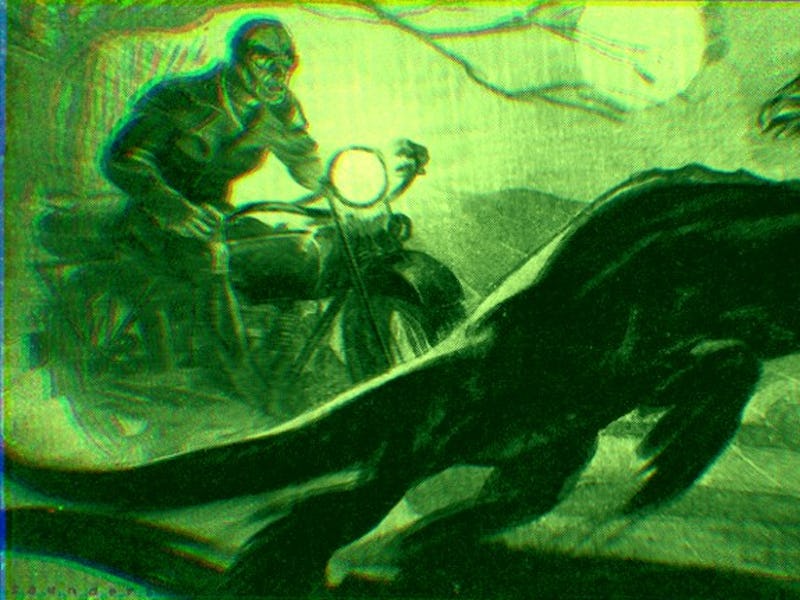Origin of Loch Ness Monster and Other Sea Serpents Traced to Odd Phenomenon
A form of mania gripped the world.

The Loch Ness Monster is perhaps our most famous sea monster, known for drowning locals in front of saints and avoiding motorcycles on its early morning cruise back to the loch. But Scotland’s Nessie is just one of the many, many sea monsters people have allegedly seen. In the 19th century, saying you saw a sea monster was very common indeed. And the reason why this happened, a new study in Earth Science History argues, is based on something very real.
"May it not be the Plesiosaurus or a species of that fish, known to have existed formerly in the waters of the ocean?"
The collective illusion — that creatures in the water were actually mysterious monsters of the deep — was driven by so-called “dino-mania,” researchers reported this week. This conclusion is based on their statistical analysis of the nature of sea monster reports from 1801 to 2015.
Charles Paxton, a statistics and mathematics research fellow at St. Andrews University, and Darren Naish, Ph.D., a paleontology researcher at the University of Southhampton, co-authored this study. They are the first scientists to seriously test a theory first posited by American science fiction writer L. Sprague de Camp — famous for coining the abbreviation “E.T.” — in 1968. His hypothesis, reprinted in the study, is this:
After Mesozoic reptiles became well-known, reports of sea serpents, which until then had tended towards the serpentine, began to describe the monster as more and more resembling a Mesozoic reptile than like a plesiosaur or mosasaur.
This hypothesis is rooted in the idea that, following the burst of fossil discoveries made in the 19th century, a curious thing began to happen: Reports of sea monsters began to describe a different sort of sea monster. Increasingly less common was the sight of say, a serpent, and more common were instances of seeing something more like the long-necked Plesiosaurus. The first complete skeleton of a plesiosaur was discovered within England’s “Jurassic Coast” in 1823.
For example, in 1834, a British lieutenant urgently reported that he saw a sea monster, an account that was published in newspapers around England. He said: “May it not be the Plesiosaurus or a species of that fish, known to have existed formerly in the waters of the ocean?”
The famous debunked photograph of Nessie.
To test de Camp’s theory, Paxton and Naish created an electronic database of 1,688 historical reports that included 1,543 alleged sightings of sea monsters. While they aren’t in a position to say how truthful people were being, they omitted the reports about obvious and known hoaxes (like the famous, grainy photograph of Nessie above).
A pattern emerged in the data. Gradually, over the last two centuries, there’s been a decline in serpent-like monster depictions and an increase in reporters describing monsters with large, dinosaur-like necks. This finding, Paxton explained, demonstrates that “the discovery of long-necked marine reptile fossils in the 19th century does appear to have had an influence on what people believe they have spotted in the water.”
Paxton also told The Telegraph that this study shows that statistics can be used to rigorously test strange hypotheses, “if the data is handled in the right way.” Maybe that means one day we’ll figure out what was the deal behind all those clown sightings in 2016.
Abstract:
Here we test the hypothesis, first suggested by L. Sprague De Camp in 1968, that “After Mesozoic reptiles became well-known, reports of sea serpents, which until then had tended towards the serpentine, began to describe the monster as more and more resembling a Mesozoic marine reptile like a plesiosaur or a mosasaur.” This statement generates a number of testable specific hypotheses, namely: 1) there was a decline in reports where the body was described as serpent or eel-like; 2) there was an increase in reports with necks (a feature of plesiosaurs) or reports that mentioned plesiosaurs; and 3) there was an increase in mosasaur-like reports. Over the last 200 years, there is indeed evidence of a decline in serpentiform sea serpent reports and an increase in the proportion of reports with necks but there is no evidence for an increase in the proportion of mosasaur-like reports. However, witnesses only began to unequivocally compare sea serpents to prehistoric reptiles in the late nineteenth century, some fifty years after the suggestion was first made by naturalists.